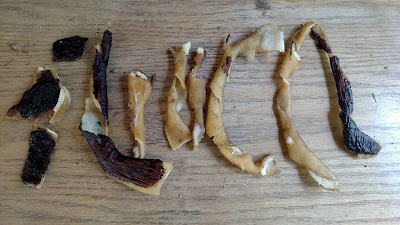How to Make Pork Skin Dog Treats at Home
I'm not sure if this post is better described as a recipe or as a craft project, but your dog will see these pork skin chews as a real treat no matter what you call the process.
Our wonderful pup is seventy pounds of fuzzy, adorable joy. We're particular about what he eats, but who wouldn't be? We've read and heard of too many horror stories detailing the commercial pet food industry as a catch-all for anything and everything.
While our dog enjoys unbleached rawhide rolls (made in the USA) on occasion, they're not the easiest thing for him to digest. While talking to Oliver at North Woods Ranch, he mentioned pork skin was a much better alternative. I've written about using North Wood's pork skin for cracklin's and making homemade stock, so it only seemed natural that a food I'd be willing to eat myself would also be a good choice for my dog.
Making pork skin treats for your own dog is actually very simple. If you can bring a pot of water to a simmer, you're halfway there.
Start by rolling out the pork skin and cutting it into thick strips. It'll shrink a bit, so aim for about 2" wide strips. Put the strips into a pot of water and simmer for about 90 minutes. This will tenderize the skin and also soften any fat attached to the skin.
Remove the excess fat by using the flat back of a knife to scrape the soft white fat away. After cooking the skin will be opaque, so it's easy to identify the white layer of fat. While this fat might be too rich to give your dog as a treat, it's still perfect for greasing a skillet or cooking potatoes.
Once most of the fat is gone, it's time to firm up the skin into chewy treats. My original plan was to braid the skin for thicker chews, but it didn't work as I had planned. So I just rolled them up like a paper towel roll. I don't think my dog minded, though.
Finally, I dried the skin in a dehydrator for 8-10 hours. If you don't have a dehydrator handy, an oven set to low (170 F) would work. The skin changed from a cloudy, opaque look to a shiny, almost-clear appearance as it dried.
 As an added treat, I did a test run and basted a couple in a little bit of Berkshire pork blood. For those, I heated the blood in a skillet for 2-3 minutes to thicken it, then brushed it on like a BBQ sauce before dehydrating the skin.
As an added treat, I did a test run and basted a couple in a little bit of Berkshire pork blood. For those, I heated the blood in a skillet for 2-3 minutes to thicken it, then brushed it on like a BBQ sauce before dehydrating the skin.
As any pet owner will admit, they know their own pet best. If your dog is the type to swallow large hunks of rawhide, pork skin will not slow their aggressive chewing. The best course of action is to keep an eye on your pet to make sure they're not eating too much/too large of pieces in their animal excitement for something extra delicious.
For one package of skin, I ended up with nine "sticks," plus 3-4 broken pieces from my initial attempt to braid the pork strips.
Our wonderful pup is seventy pounds of fuzzy, adorable joy. We're particular about what he eats, but who wouldn't be? We've read and heard of too many horror stories detailing the commercial pet food industry as a catch-all for anything and everything.
While our dog enjoys unbleached rawhide rolls (made in the USA) on occasion, they're not the easiest thing for him to digest. While talking to Oliver at North Woods Ranch, he mentioned pork skin was a much better alternative. I've written about using North Wood's pork skin for cracklin's and making homemade stock, so it only seemed natural that a food I'd be willing to eat myself would also be a good choice for my dog.
Making pork skin treats for your own dog is actually very simple. If you can bring a pot of water to a simmer, you're halfway there.
Start by rolling out the pork skin and cutting it into thick strips. It'll shrink a bit, so aim for about 2" wide strips. Put the strips into a pot of water and simmer for about 90 minutes. This will tenderize the skin and also soften any fat attached to the skin.
Remove the excess fat by using the flat back of a knife to scrape the soft white fat away. After cooking the skin will be opaque, so it's easy to identify the white layer of fat. While this fat might be too rich to give your dog as a treat, it's still perfect for greasing a skillet or cooking potatoes.
Once most of the fat is gone, it's time to firm up the skin into chewy treats. My original plan was to braid the skin for thicker chews, but it didn't work as I had planned. So I just rolled them up like a paper towel roll. I don't think my dog minded, though.
Finally, I dried the skin in a dehydrator for 8-10 hours. If you don't have a dehydrator handy, an oven set to low (170 F) would work. The skin changed from a cloudy, opaque look to a shiny, almost-clear appearance as it dried.
 |
| Average Size of the Pork Chews |
 As an added treat, I did a test run and basted a couple in a little bit of Berkshire pork blood. For those, I heated the blood in a skillet for 2-3 minutes to thicken it, then brushed it on like a BBQ sauce before dehydrating the skin.
As an added treat, I did a test run and basted a couple in a little bit of Berkshire pork blood. For those, I heated the blood in a skillet for 2-3 minutes to thicken it, then brushed it on like a BBQ sauce before dehydrating the skin. As any pet owner will admit, they know their own pet best. If your dog is the type to swallow large hunks of rawhide, pork skin will not slow their aggressive chewing. The best course of action is to keep an eye on your pet to make sure they're not eating too much/too large of pieces in their animal excitement for something extra delicious.
For one package of skin, I ended up with nine "sticks," plus 3-4 broken pieces from my initial attempt to braid the pork strips.
 |
| Bonne Bouche ate two before I snapped this photo |







Comments
Post a Comment